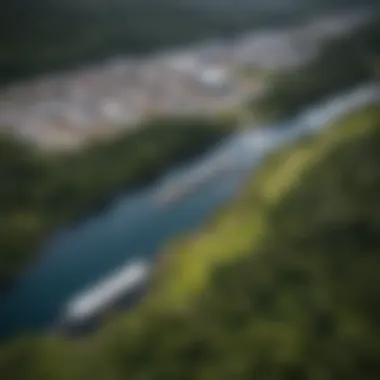Water Catchment Systems in Hilo: An In-Depth Analysis


Intro
Water catchment systems play a pivotal role in managing and conserving water resources, particularly in regions like Hilo, Hawaii. Given the unique geographical and climatic conditions of this area, the management of water resources is complex but essential. These systems are designed to gather and store rainwater, making it a critical component of both domestic and communal water supply. Understanding how these systems function will allow stakeholders to better appreciate their significance in promoting sustainable use of water in Hilo.
In this article, we examine various facets of water catchment systems in Hilo. By delving into their historical context, current implementations, and future advancements, we aim to present a comprehensive picture that appeals to students, researchers, and professionals within the field.
Let us explore the overview of our findings and set the stage for further discussions.
Prologue to Water Catchment
Water catchment systems play a vital role in managing local water resources, particularly in regions like Hilo where rainfall is abundant. They are essential for collecting, storing, and distributing water effectively. This introduction focuses on the significance of water catchment systems in Hilo, emphasizing their benefits and the various considerations involved.
Definition and Importance
A water catchment system is defined as the areas that collect and channel rainfall to specific locations where it can be stored for future use. In Hilo, this system is crucial due to the high levels of precipitation, which can reach up to 150 inches annually. By capturing rainwater, these systems help mitigate flooding, conserve water, and provide a sustainable source for agricultural and domestic needs.
The importance of water catchment systems in Hilo cannot be overstated. They not only enhance water security but also contribute to ecological sustainability. By allowing for the natural replenishment of aquifers, they support the overall health of local ecosystems. Moreover, these systems reduce dependency on external water sources, promoting self-reliance within the community.
Historical Context
Historically, Hilo has a rich tradition of managing water catchment. Ancient Hawaiian communities developed sophisticated methods to divert water from streams and rivers into storage basins. This knowledge is a product of centuries of adaptation to the local environment. With the arrival of Western influences, modern practices were integrated, reflecting both traditional and contemporary approaches.
In the 20th century, as urban development increased, the importance of systematic water management became evident. The reliance on catchment systems grew, as more residents recognized the benefits of utilizing local resources effectively. Today, understanding Hilo’s historical context regarding water catchment systems allows for a better appreciation of current practices and challenges.
Hilo's Geographic and Climatic Features
Hilo's geographic and climatic features significantly influence its water catchment systems. This region showcases a unique blend of natural elements that contribute to both the abundance and management of water resources. Understanding these features is crucial for anyone interested in the complexities surrounding water conservation and management strategies in Hilo.
Topography of Hilo
Hilo is characterized by a mountainous landscape, with the Mauna Loa and Mauna Kea volcanoes shaping its topography. These elevations play a critical role in the hydrology of the region. The steep slopes facilitate rainwater runoff and contribute to the formation of numerous streams and rivers. The natural gradient helps in capturing moisture and directing it toward lower areas, where water accumulation can occur.
Furthermore, the proximity of Hilo to the ocean adds another layer of complexity. It experiences orographic rainfall, where moist air from the sea rises over the mountains, cools, and results in precipitation. Thus, the topography does not just affect where water flows, but also impacts how much water is available for catchment systems and overall community use.
Rainfall Patterns
Hilo is known for its high annual rainfall, averaging around 130 inches per year. This is significantly above the national average, making it essential for effective water management strategies. The rainfall is not uniform throughout the year; instead, it often occurs in heavy bursts during certain months. Understanding these patterns is vital for forecasting water supply and planning catchment systems accordingly.
Rainfall in Hilo is influenced by various climatic variables, including seasonal trade winds and the El Niño phenomenon. These factors contribute to year-to-year variations in precipitation, emphasizing the need for adaptable water management systems. Incorporating data on rainfall patterns can help local policymakers and planners forecast water availability and implement effective catchment strategies.
Impact of Climate Change
The implications of climate change on Hilo’s water catchment systems are profound. Rising temperatures and changing weather patterns can alter historical rainfall distributions. For instance, certain studies suggest that Hilo may experience more intense storms while having periods of drought, complicating water resource management.
As the climate shifts, the increased occurrence of extreme weather events can lead to challenges in both water quality and infrastructure resilience. Flooding may cause erosion and disrupt water systems, while drought could strain the supply available for local use. Adapting to these changes involves incorporating climate change projections into planning and developing resilient systems that can withstand these challenges.
Adapting to climate change is not merely beneficial; it is necessary to ensure the sustainability of water resources in Hilo.
The geographic and climatic features of Hilo are interconnected with its water catchment systems. An understanding of these aspects is essential in crafting effective management practices that are resilient to both current conditions and future uncertainties.
Types of Water Catchment Systems
Understanding the types of water catchment systems is essential for addressing water scarcity and optimizing resource management in Hilo. These systems play a crucial role in collecting and storing rainwater for various uses. Recognizing their characteristics and applications allows stakeholders to implement strategies that enhance sustainability, efficiency, and community resilience.
Traditional Methods
Traditional water catchment methods have been utilized by local communities for generations. One of the most notable techniques is the use of simple cisterns, which collect and store rainwater during precipitation events. Roof catchment systems also play an important role, directing water from rooftops into storage tanks. Such methods are low-cost and require minimal technology, making them accessible for many households.
In addition, the construction of terraces and check dams has been common in rural areas. These methods slow down water runoff and increase absorption into the ground. This not only helps to recharge aquifers but also reduces soil erosion, contributing positively to agricultural practices in the region.


Modern Technological Approaches
Modern technological approaches to water catchment systems have revolutionized the way communities manage their water resources. Utilizing advanced materials and processes, these systems are often highly efficient and adaptable to various settings. For example, the introduction of modular rainwater harvesting systems allows for easier installation and maintenance, encouraging more residents to adopt sustainable practices.
Furthermore, automation in water catchment systems has gained traction. Sensors can monitor water levels in storage tanks and trigger alerts when maintenance is needed. This modern technology reduces dependence on manual checks and enhances overall operational efficiency, playing a vital role in urban planning in Hilo.
Integration of Smart Technology
The integration of smart technology into water catchment systems reflects an important trend towards data-driven management. Smart meters now enable real-time monitoring of water quality and quantity. Such data is invaluable, allowing for timely interventions and informed decision-making.
Moreover, community-based apps could encourage engagement and education regarding water conservation. By providing easy access to information on local water resources and catchment practices, residents can take ownership of their water management responsibilities.
Innovations in smart technology will not only streamline existing systems but will also empower communities to utilize their natural resources responsibly.
In summary, the diversity in water catchment systems reflects both historical practices and modern advancements. Each method offers unique benefits and considerations, making it vital for Hilo to adopt a holistic view when planning for the future.
Local Policies and Regulations
Local policies and regulations serve as the backbone of sustainable water management in Hilo. They provide structure and authority for the implementation of water catchment systems, ensuring that practices align with broader environmental and community goals. Effective policies not only safeguard the water supply but also balance the needs of local ecosystems and residents. For Hilo, where rainfall patterns are inconsistent, establishing sound policies becomes a necessity rather than an option.
Water Management Frameworks
The water management frameworks in Hilo encapsulate the strategic approaches used to regulate and govern water catchment systems. These frameworks are typically developed by local authorities in collaboration with community stakeholders.
The frameworks involve multiple elements:
- Regulatory Standards: Clear guidelines that dictate how water catchment systems should be designed and maintained.
- Resource Allocation: Strategies to efficiently use available water resources, ensuring all community needs are met.
- Enforcement Mechanisms: Procedures for monitoring compliance with the established guidelines.
This structured approach results in long-term sustainability of water resources. Stakeholders, including residents, businesses, and environmental organizations, must be involved for the framework to be truly effective. The frameworks adapt to the changing environment and local needs through regular assessments and updates.
Governmental Role in Water Conservation
The government plays a critical role in water conservation efforts. In Hilo, state and local governments are responsible for overseeing the implementation of water policies. They ensure that water catchment systems function effectively while addressing the increasing demands posed by climate change and population growth.
"Active governmental participation is essential in maintaining both quality and quantity of water supply."
Government initiatives often include:
- Funding Programs: Financial support for community projects that aim to enhance water catchment capabilities.
- Education Campaigns: Initiatives designed to inform residents about water conservation practices and their impacts.
- Partnerships: Collaborations with local organizations to develop sustainable practices and technologies.
Such roles draw on expertise and resources that a single community may not possess.
Community-based Initiatives
Community participation is vital in fostering effective water management practices. Hilo has seen several community-based initiatives that promote local involvement and stewardship. These initiatives often empower residents to take charge of their water resources, fostering a sense of ownership and responsibility.
Many community initiatives include:
- Workshops and Training: Teaching locals about effective catchment techniques and maintenance practices.
- Volunteer Programs: Engaging residents in hands-on projects like clean-up drives and the installation of catchment systems.
- Feedback Mechanisms: Encouraging residents to share their experiences and suggestions regarding local water policies.
These efforts contribute to a sustainable water future and enhance community resilience against water shortages. By involving the community in water management, Hilo sets a precedent that can serve as a model for other regions.
Environmental Impacts
Understanding the environmental impacts of water catchment systems is crucial for ensuring sustainable water resource management in Hilo. These impacts can shape not only the local ecosystems but also the water quality and overall biodiversity in the area. The inclusion of these elements offers insights into how catchment systems function and their long-term implications for both the environment and the community.
Effects on Local Ecosystems
Water catchment systems profoundly influence local ecosystems by regulating the availability of water. These systems work by collecting and storing rainwater, which can help stabilize local water supplies during dry periods. By ensuring a consistent water source, these systems can support various plant and animal species that rely on specific moisture levels for survival. Furthermore, by maintaining a balanced hydrology, local flora and fauna can thrive, thus promoting ecological diversity.
However, improper management of these systems can result in negative consequences. For instance, if water catchment systems degrade, it can lead to reduced water quality, affecting not only aquatic habitats but also terrestrial ecosystems that depend on healthy waterways.


Water Quality Concerns
Water quality is a significant consideration in the context of water catchment systems. Catchment areas can become contaminated from various sources such as agricultural runoff, urban pollutants, and sedimentation. As these contaminants enter the water supply, they pose serious risks to public health and the environment.
Factors influencing water quality include:
- Land use practices: Urban development may increase impervious surfaces, leading to more runoff that carries pollutants.
- Erosion and sedimentation: Poorly managed catchment areas can increase sedimentation, which can decrease water clarity and harm aquatic life.
- Pesticides and fertilizers: Agricultural activities can contribute chemicals that deteriorate water quality.
Maintaining rigorous monitoring and effective filtration processes is necessary to mitigate these concerns.
Biodiversity and Habitat Preservation
Biodiversity is essential for healthy ecosystems. Water catchment systems play a pivotal role in preserving habitats by providing crucial resources like water and shelter for numerous species. A well-designed catchment system can enhance biodiversity by supporting diverse plant and animal communities.
Moreover, proper habitat preservation strategies should be integrated into the design and management of water catchment systems. This includes:
- Restoration of native vegetation: Supporting native plant species can enhance habitat stability and provide sustenance for local wildlife.
- Creation of buffer zones: Establishing vegetative buffers around catchment areas can help protect water quality and create habitats.
- Community education and involvement: Encouraging local communities to participate in biodiversity conservation can lead to better management practices.
"The impact of water catchment systems extends beyond water supply; they are vital for preserving the intricate web of life in Hilo."
Challenges in Water Catchment Management
Water catchment management in Hilo presents a complex interplay of challenges that directly impact the sustainability and efficiency of the region's water resources. Understanding these challenges is crucial for devising effective strategies to ensure a reliable supply of water while preserving the local environment. This section explores critical issues such as infrastructure limitations, the importance of community awareness, and the ever-pressing need for adequate funding and resource allocation in the management of water catchment systems.
Infrastructure Limitations
Infrastructure is the backbone of any successful water catchment system. In Hilo, aging infrastructure often limits the capacity to collect, store, and distribute water efficiently. Many existing systems are outdated and require significant upgrades to meet contemporary standards. The limitations in infrastructure can lead to several issues, including:
- Inefficient water collection: Old gutters and reservoirs may not capture rainfall effectively.
- High rates of leakage: Deteriorated pipes result in preventable water loss, undermining resource management efforts.
- Inadequate storage capacity: Increased rainfall and changing weather patterns necessitate larger storage systems. However, current facilities often fall short.
Addressing these infrastructure limitations will require a comprehensive assessment of existing assets and a strategic plan for enhancements. Investing in modern materials and technology can help alleviate some of these issues while also preparing the systems for future environmental changes.
Community Awareness and Education
Community awareness plays a vital role in the success of water catchment initiatives. Engaging local residents fosters a sense of responsibility for sustainable water management practices. A lack of knowledge can lead to inefficient water use and exacerbate existing problems. Key elements include:
- Education Programs: Implementing outreach initiatives to inform the community about the importance of water catchment systems and environmental conservation.
- Workshops and Seminars: Offering practical training on how individuals can contribute to water conservation at home and support local initiatives.
- Promotion of Participation: Encouraging community involvement in monitoring and maintaining catchment areas.
Strengthening community awareness will empower residents to take action, effectively reducing pressure on the water catchment systems while enhancing the sustainability of local resources.
Funding and Resource Allocation
Sustainable water management is often hampered by insufficient funding and poorly allocated resources. Projects for upgrading infrastructure or implementing new technologies require significant financial investment. Key challenges include:
- Finding Reliable Sources of Funding: Local governments may struggle to secure adequate budget allocations for necessary improvements.
- Strategic Resource Distribution: An effective management plan must prioritize projects based on immediate needs and long-term benefits.
- Collaboration with Stakeholders: Engaging with public and private organizations can lead to opportunities for funding and resource sharing.
To promote effective water catchment management, it is essential to develop innovative funding solutions that reflect the unique needs of Hilo's water systems. By doing so, it will be possible to ensure that resources are utilized effectively for the benefit of both the community and the environment.
"Investing in infrastructure, community engagement, and funding is not just a necessity, but a responsibility towards future generations."
Future Directions in Water Catchment
Understanding the future of water catchment systems is critical for addressing the growing challenges of water scarcity and environmental sustainability. Hilo's unique geographic features and climatic conditions necessitate innovative approaches in water management. The advancements in technology, evolving policies, and heightened community involvement are pivotal components that need thorough exploration.
Emerging Technologies
Emerging technologies offer promising solutions for enhancing water catchment systems in Hilo. For example, rainwater harvesting systems are becoming more efficient thanks to new materials and design methodologies. Various applications of sensors enable real-time monitoring of water levels and quality, effectively alerting authorities to any changes that may impact public health.
Cloud computing plays a vital role as well. It allows for the aggregation of data from multiple sources, which can be analyzed to predict water availability and demand patterns. This is particularly useful as climate variability becomes more pronounced. Utilizing predictive analytics will help in strategic planning to allocate water resources effectively.


Moreover, innovative filtration systems using nanotechnology can substantially improve water purity, making collected rainwater safe for various uses. These advancements not only facilitate efficient management but also significantly reduce costs associated with water treatment.
Policy Innovations
Policy innovations are essential to encourage sustainable water management practices. Adaptive policies can help ensure that regulations stay relevant and effective in the face of changing environmental conditions. Collaborative governance can create synergies between governmental bodies and local stakeholders, facilitating information exchange and resource sharing.
Effective policy frameworks must include incentives for adopting new technologies and practices. For instance, tax credits for households investing in rainwater collection and usage can foster greater community participation. Striking a balance between regulatory measures and economic incentives is fundamental to foster a culture of conservation in Hilo.
Furthermore, policies should be designed to address equity in water access. Ensuring that water resources are allocated fairly across different communities can mitigate potential conflicts and bolster social cohesion.
Community Engagement Strategies
Community engagement is vital to ensure the success of water catchment initiatives. Leveraging local knowledge can enhance the design and implementation of projects. Workshops and community forums can raise awareness about water issues and gather feedback on proposed systems meant to improve water management.
By fostering a sense of ownership, local residents are more likely to participate actively in conservation efforts. Educational programs in schools can instill values related to sustainability from a young age. These initiatives will empower future generations to take responsibility for water resources.
Utilizing social media platforms and online communities can also facilitate ongoing discussions about water management issues. Creating channels for feedback can guide local officials in policy development and provide insights into community needs and preferences.
Engaging the community in decision-making processes enhances the efficiency and effectiveness of water management strategies, creating sustainable outcomes.
Case Studies: Successful Practices
The study of successful practices in water catchment systems is vital for understanding how to optimize local resources and build resilient communities. By examining case studies, one can identify effective techniques, policy frameworks, and community engagement models that may be adapted and implemented in similar contexts. The focus on local initiatives and comparative analysis with other regions allows for a comprehensive understanding of what makes certain practices successful.
Local Initiatives in Hilo
In Hilo, various local initiatives have emerged to enhance water catchment systems. One noteworthy project involves the community-based rainwater harvesting initiative, which encourages residents to install rain barrels. These barrels collect rainfall from roofs, thus providing an alternative water supply for household uses such as gardening and cleaning. This practice not only reduces dependence on municipal water but also helps residents understand their water usage more clearly.
The government has supported initiatives such as the Hilo Watershed Partnership. This partnership brings together multiple stakeholders, including community members, landowners, and agencies. The focus has been on reforesting critical watershed areas to improve water quality and increase catchment capacity. The methods used in these local projects emphasize sustainability and community involvement.
Moreover, educational programs that raise awareness about the importance of water conservation are prevalent. These programs often feature workshops, informational brochures, and field demonstrations to teach residents about effective water catchment techniques.
"Community engagement is crucial for the success of any water management initiative; informed citizens are more likely to participate actively in conservation efforts."
Comparative Analysis with Other Regions
To gain deeper insights into effective water catchment approaches, it is useful to compare Hilo’s practices with those of other regions. For instance, in cities like Tucson, Arizona, the use of sand tanks as a means to store rainwater is well-documented. These structures allow for greater evaporation control and water retention during periods of drought, a technique that could benefit Hilo given its unique rainfall patterns.
Additionally, analyzing Singapore’s integrated urban water management solutions provides valuable lessons. Singapore employs a holistic approach, incorporating rainwater collection, recycling, and advanced treatment systems to optimize water use. This level of innovation contrasts with traditional practices in Hilo, thus posing questions about the balance between technology and community-centric methods.
In comparing these case studies, one identifies key factors such as:
- Technological integration
- Community engagement
- Policy support
- Environmental considerations
These elements facilitate both effectiveness and sustainability in water catchment systems. They also highlight the importance of adaptability in local contexts. Hilo can draw inspiration from these successful practices while tailoring their implementation to fit regional needs.
Through case studies, both local and from other regions, a clearer picture emerges. It reinforces the idea that shared experiences can guide successful water management practices for Hilo, ultimately contributing to more resilient community systems.
The End
Water catchment systems are crucial to the sustainable management of Hilo’s water resources. This section underscores the overall significance of these systems, emphasizing their multifaceted benefits, various considerations, and the prevailing challenges.
Summary of Key Findings
The analysis has revealed several important insights regarding Hilo's water catchment systems:
- Importance of Rainfall: Hilo receives significant rainfall, averaging over 150 inches annually, which presents an opportunity for effective water catchment practices.
- Diverse Methods: Both traditional and modern catchment techniques coexist, illustrating the community's adaptability and innovation.
- Local Ecosystem Effects: Proper management of catchment systems supports local ecosystems and enhances biodiversity.
- Funding Issues: Insufficient funding and community awareness remain obstacles to maintaining and upgrading catchment infrastructure.
In summary, the findings highlight how comprehensive water catchment systems not only address local water needs but also contribute to environmental sustainability and community resilience.
Implications for Future Research
Several avenues for future inquiry emerge from this analysis:
- Emerging Technologies: Further investigation is necessary to explore how new technologies can enhance the efficiency and effectiveness of water catchment systems.
- Policy Development: Research should focus on innovative policy frameworks that foster better collaboration between governmental and non-governmental entities in water management.
- Community Engagement: Understanding community dynamics is key, especially regarding educational strategies that elevate public awareness about the significance of water conservation.
Overall, ongoing research can pave the way for improvements in water catchment practices, ensuring a sustainable future for Hilo's valuable water resources.







